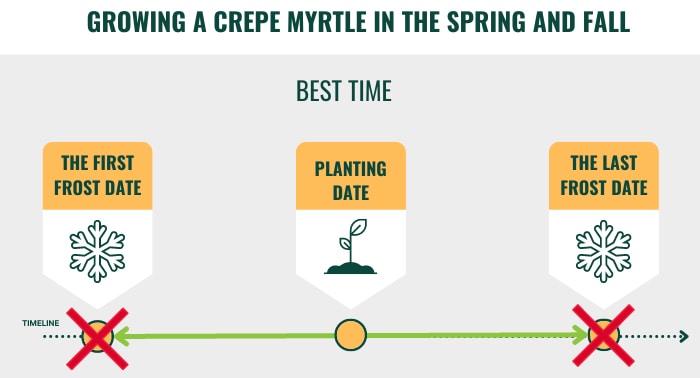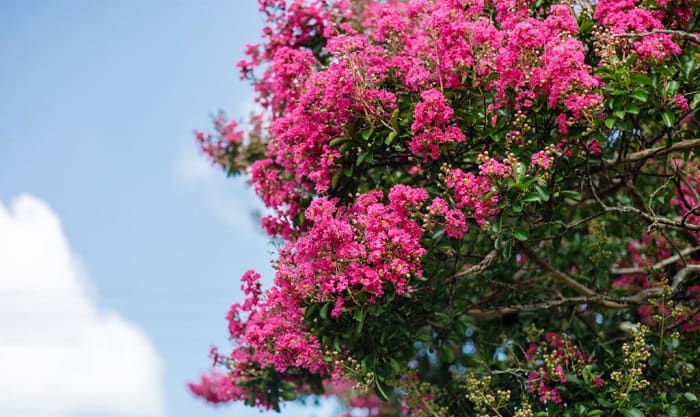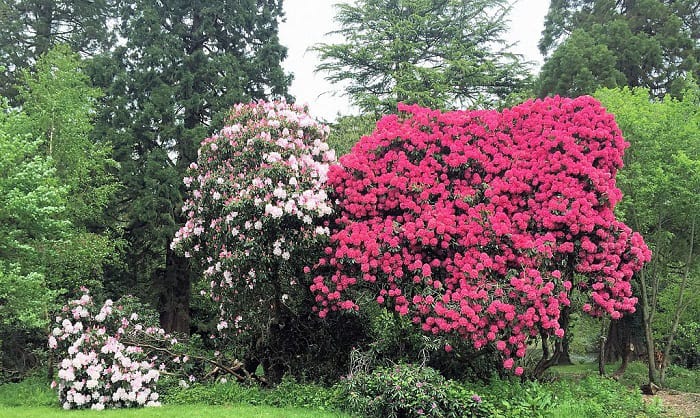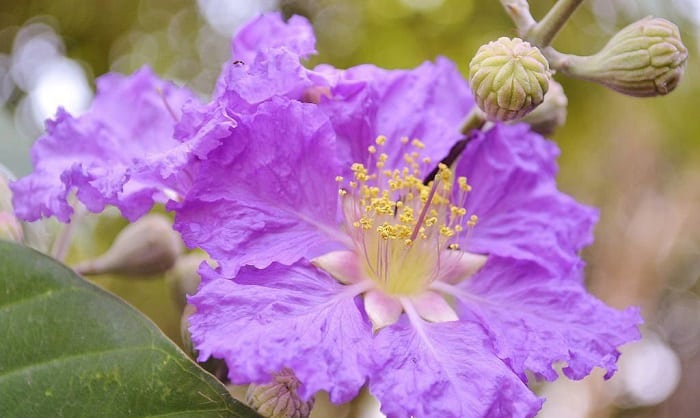Crepe myrtles are ubiquitous in the south, and unsurprisingly so, given that they thrive in hardiness zone 7 to 10.
If you live in hotter areas of the US, it’s possible to enjoy this tree’s colorful flowers from summer to fall, so long as you know when is the best time to plant a crepe myrtle.
In short, the ideal months for growing this plant are June to late September. Learn how to cultivate it below.
Table of Contents
Best Time to Grow a Crepe Myrtle
There aren’t many rules regarding when to plant crepe myrtle trees. Simply grow them when there’s no frost in the spring and fall. In other words, avoid both the first and last frosts when starting this plant, and you should be fine.
Planting crepe myrtle in summer is possible, but you’d have to be very careful about watering it, since the tree will need more moisture to survive.
With that said, here are some general rules on growing different types of crepe myrtles. Note that people often transplant this shrub instead of using seeds, since seeds will not produce plants that are identical to the parent tree.
Growing Different Types of Crepe Myrtle
Stores offer three main types of crepe myrtles: container, ball or burlapped, and bare-root plants.
Container types are the least demanding and could be grown any time of the year (provided there’s no frost, of course). The other crepe myrtles, however, will do best with a spring or fall planting when the plant is going through dormancy.
Should you choose to sow crepe myrtle seeds, the timing is pretty much the same: seed the tree in late spring in a container with a seed starting mix.
Slightly dampen the starting mix, then cover the container with a ziplock bag and keep it in a warm, sunny environment. After a month or so, the seeds will germinate and reach two inches in height, at which point you can remove the bag and keep caring for the plant until it’s one-foot tall.
Afterward, transplant your crepe myrtle seedling outside in summer or early fall.
Climates for Crepe Myrtles
- Tropical climates are ideal for crepe myrtles because they favor warm weather and a high moisture level.
However, these plants will still grow if only one of these conditions are met.
For example, crepe myrtles in dry climates will still thrive with frequent irrigation, and those in regions with mild winters and cooler summers will still flower, though not as well due to the lack of heat.
In contrast, extremely cold places with no humidity (like polar regions) won’t accommodate these plants at all.
- Climates aside though, crepe myrtles will grow in hardiness zone 6 down to 5, provided you give them proper care.
To be specific, put your plants in containers and move them indoors during winter after the first freeze. Once spring comes, gradually acclimate them to warm temperatures before transferring them outside.
Why is this important? Without this change in weather from cold to warm, crepe myrtles won’t know when to break dormancy.
Planting Time for Some Areas or States
Unsure when is the best time of year to plant crepe myrtles? Here are the recommendations for some regions in the United States to make planting crape myrtle trees easier for you.
| Hardiness zones | Location | Crepe myrtle planting time (estimate) |
| Zone 5 to zone 8 (5a to 8a) | Virginia | April to October |
| Zone 5b to 8a | Maryland | April to November |
| Zone 5b to 8b | North Carolina | April to October |
| Zone 8a to 11a | Florida | February to November. Anytime for frost-free areas. |
| Zone 6b to 10a | Texas | February to November. Anytime for frost-free areas. |
What Are Different Crepe Myrtle Varieties?
Crepe myrtle varieties fall under four categories: dwarf, semi-dwarf, medium, and large. Dwarf and semi-dwarf types grow up to 4 and 12 feet, respectively, while medium and large varieties reach up to 20 or 40 feet individually.
Despite the difference in sizes, all of these crepe myrtles can grow within zone 6 to 10, depending on the cultivar. Here is a short list of crepe myrtle varieties and their basic characteristics:
| Cultivar | Hardiness zones | Flower colors | |
| Dwarf plants | Pocomoke | 6 to 9 | Pink |
| Cherry Dazzle | 6 to 9 | Red | |
| Tightwad Red | 7 to 10 | Red | |
| Semi-dwarf plants | Acoma | 6 to 9 | White |
| Hopi | 6 to 9 | Pink | |
| Tonto | 6 to 9 | Red | |
| Zuni | 6 to 10 | Lavender | |
| Medium plants | Catawba | 7 to 9 | Violet-purple |
| Centennial Spirit | 6b to 9 | Rose red | |
| Burgundy Cotton | 6b to 10 | White | |
| Large plants | Biloxi | 7 to 9a | Pink |
| Muskogee | 6 to 9 | Lavender | |
| Natchez | 6 to 9b | White |
Note:
Depending on which types you’re growing, the spacing for them will differ. For example, Acoma trees can have a maximum width of 10 feet, so 10 feet can be the distance between two saplings.
Look up the size of the variety you’re growing to be sure, or follow the general guidelines below:
- Dwarf and semi-dwarf plants – 1.5 to 6 feet apart for hedges and 3 to 10 feet apart for separate trees
- Medium plants – 6 to 10 feet apart for cover, 10 to 15 feet apart if you don’t want a privacy screen
- Large plants – 8 to 12 feet apart for cover, 10 to 15 feet apart otherwise
Plant and Care Tips
1. How to plant crepe myrtles
At least three months before planting, ensure the soil has a pH of 6 to 7.3, and use lime or aluminum sulfate to increase or lower the soil’s acidity.
When it’s time to plant crepe myrtles, loosen the ground where you intend to grow them. Usually, a 3×3 feet patch should be large enough for one plant. If the ground is sandy, add peat moss to improve moisture retention.
With all preparations done, dig a hole three times as wide as the crepe myrtle roots and as deep as the pot holding them. Water the root ball and the hole you dug before putting the plant into the soil. Note that the top of the roots should be visible above-ground.
Finally, backfill the excavated area and step on the ground with your feet. Water the soil again to help the plant settle in.
2. How to care for crepe myrtles
Watering is very important for crepe myrtle maintenance. So, give the plant an inch of water every week or whenever the top inch of the soil feels dry. You can mulch the tree with two to four inches of hardwood to conserve moisture, provided the mulch doesn’t touch the trunk.
And remember: once the plant enters dormancy, there’s usually no need to water it. At most, crepe myrtles will be fine with one watering per week during winter.
If you want to fertilize them, use a balanced formula during spring or whatever your soil test recommends. Crepe myrtles will grow well if given monthly fertilization in their first year of life, but from the second year on, feeding them once annually will do.
Just as importantly, it’s best to give these trees six to eight hours of direct sunlight per day, or shade will impede flowering.
Frequently Asked Questions
1. Are crepe myrtles easy to grow?
Yes. Crepe myrtles will grow in pretty much any soil, even clay ones. These plants are tolerant of heat and air pollution, and once established, will only need watering once or twice a month.
2. Where is the best place to plant crepe myrtles?
Over the years, I have seen people grow crepe myrtles near pools, sidewalks, and driveways. However, you can put these plants anywhere you want, provided they have enough space to spread without blocking the windows or touching other parts of the house.
One caveat though—be prepared to sweep or remove the flowers once they die, and consider which area of your home is the easiest to clean. If you ask me, I’d rather blow my lawn than deal with a pool.
Plus, look up your variety’s height and width before ordering it. This way, you won’t be stuck purchasing a variety that’s too big for your home and wasting a good time to plant crepe myrtles.
3. How long does it take a crepe myrtle to get established?
Expect to wait three to five years for a crepe myrtle to become mature enough and begin flowering. If you’re lucky, the plant may produce blossoms during its second season.
Conclusion
When is the best time to plant a crepe myrtle is a common question among homeowners.
To reiterate, you should grow this shrub in spring and fall and pair it with cherries, evergreens, and hydrangeas, all of which will complement each other and beautify your landscape.
Have you decided the best month to grow crepe myrtles yet? Tell us about it below.
Read more:

Hi, I am William – Floridayards’ digital content creator. My job is to find answers to all your concerns with thorough research and our team’s expert advice. I will also bring you honest reviews on the best products and equipment for raising your beautiful garden. Please look forward to our work!















